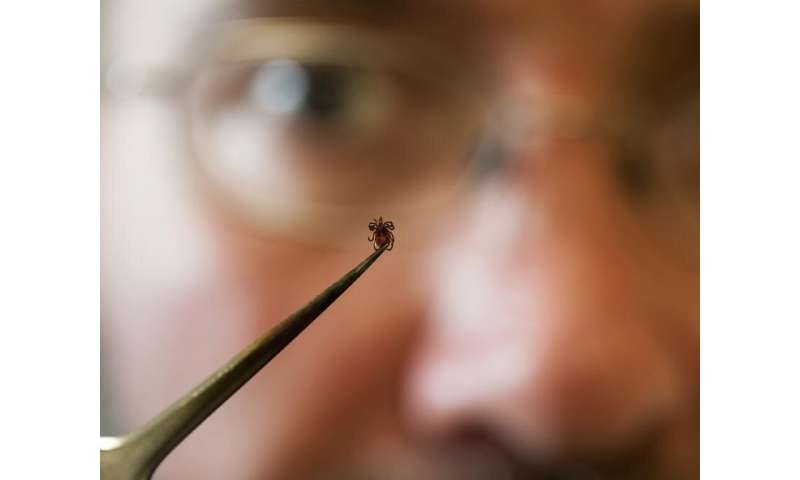
According to figures compiled by the Laboratory of Medical Zoology (LMZ), a national tick-testing service at the University of Massachusetts Amherst, tick submissions from California increased by just under 250 percent from 2017 to 2018, the largest single increase from any state, and are on track to match that level this year, as well, predicts microbiologist and LMZ director Stephen Rich.
Even more surprising is that tick test orders from Californians now edges out tick test requests from traditionally endemic states with smaller populations such as Vermont, New Jersey, Pennsylvania and Connecticut, he adds.
The 11-year passive surveillance data reported by LMZ reveal that most of the Lyme disease bacteria in these western ticks was found in non-western, non-endemic species, Rich says. “Those tick bites and the Lyme disease were associated with travel to the eastern United States,” he adds. “Our data show that only 2 percent, or 9 of 430 native ticks, had Lyme there while 25 percent, or 30 of 119 infected ticks originated in the East but were plucked off of people in the West. That means that the threat of Lyme in the West is not from their ticks, but from ours.”
Revealing this unexpected trend is one of the many new, more detailed analyses of little-studied public health endpoints related to tick-borne illness in the United States that are now possible since Rich and colleagues established the LMZ in 2006. For example, Rich and extension associate professor Guang Xu, among others, are now able to query the lab’s considerable database for such analyses as tick prevalence by region and varieties of pathogens occurring by species.
In a paper published earlier this year in the journal Vector-Borne and Zoonotic Diseases, they addressed the question of how people testing positive for Lyme disease in California, Washington and Oregon got the illness, which is far more common in the Northeast, and what tick species bit them. Results are based on LMZ’s analysis of 549 ticks from the genus Ixodes submitted to its national TickReport service from California, Oregon, and Washington from July 2006 through August 2017.
Not only the prevalence but the ecology of Lyme disease in the western U.S. differs significantly from that in the Northeast, Rich points out. The overall incidence of Lyme disease in the West is 0.2 cases per 100,000 persons per year compared to 30–80 in the Northeast. A number of tick surveillance studies have tried to connect tick data with the risk of disease in the West, but traditional tick-collecting methods are not able to link tick information and diseases they carry directly to the humans who were bitten, he adds.
Guang Xu, lead author of the LMZ study, says that among western ticks occurring there naturally, the highest incidence of Lyme-like bacteria is found in Ixodes spinipalpis, not Ixodes pacificus. “This is noteworthy because Ixodes pacificus has long been thought to be the important tick. This is less important to the average person, but it does emphasize that we still don’t understand how Lyme works in the West,” Rich says. “It seems that it is a much more complicated story than we surmised and much more complicated than in the East, where it’s basically one tick and one bacterium.”
Xu and colleagues, with co-authors at the Washington State Department of Health and California Department of Public Health, found that 430 endemic western ticks were from three Ixodes species: I. pacificus, I. spinipalpis, and I. angustus while I. scapularis was the most common species among the 119 non-endemic ticks. The researchers used real-time PCR and DNA sequencing to accurately identify each tick sample to the species level.
In the eastern and north-central United States, I. scapularis is the primary vector of several pathogens including Borrelia burgdorferi which causes Lyme disease, Borrelia miyamotoi, Anaplasma phagocytophilum and Babesia microti. In the West, the researchers note, “I. spinipalpis had the highest pathogen prevalence of the endemic species, indicating it may pose a larger public health threat than previously thought.”
In addition to differences in hosts and tick vectors, the species and population of Lyme spirochetes is more diverse in California, the authors point out. In the Northeast, Lyme borreliosis are mostly maintained in white-footed mice and other small mammals by I. scapularis ticks. Although I. pacificus ticks and similar mice are common in California, they appear relatively unimportant in the transmission cycles of Lyme borreliosis. Some tick species, such as I. spinipalpis and I. angustus are considered “rare” human biters, however their encounter frequency and public health impact are yet to be determined, they add.
Source: Read Full Article
